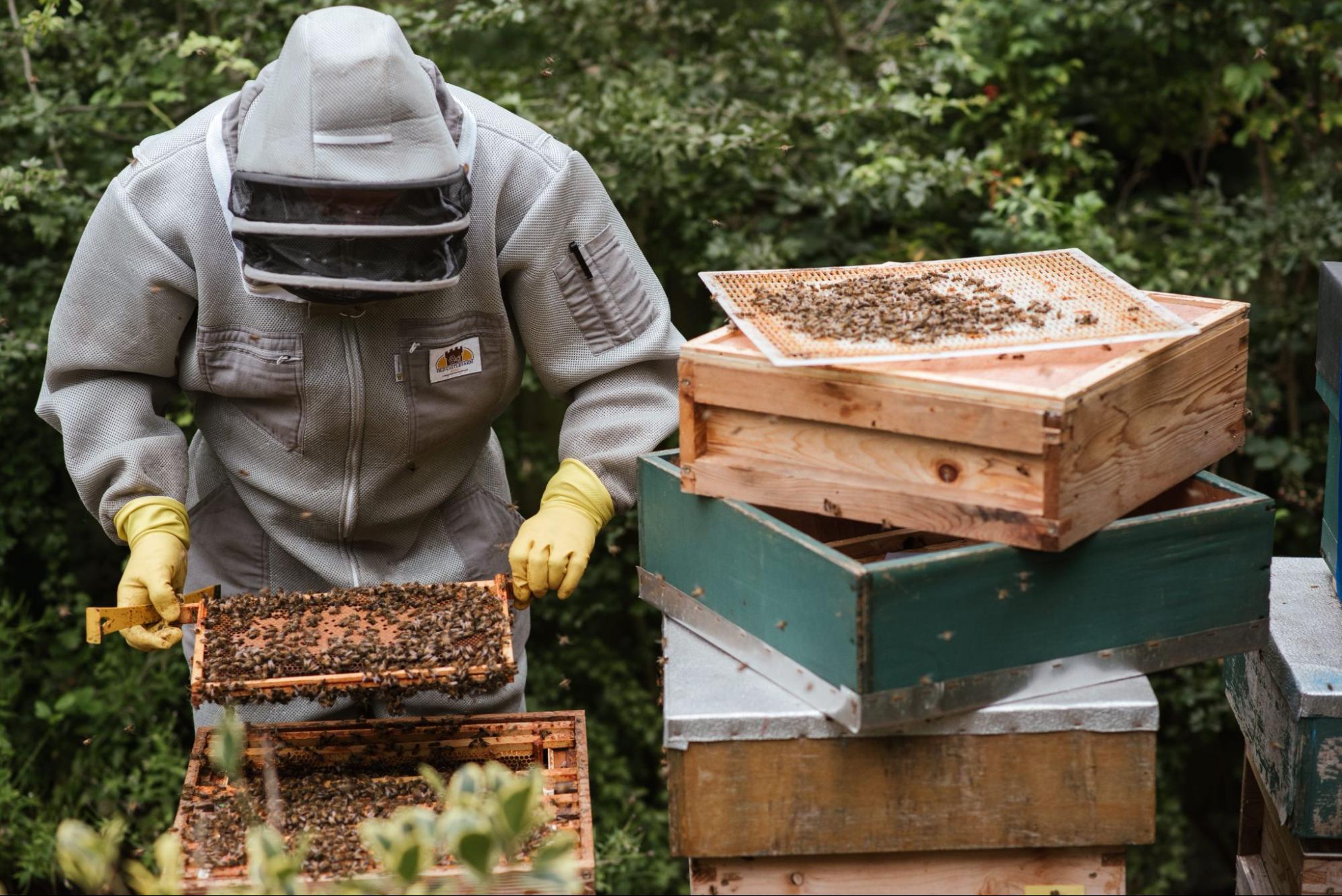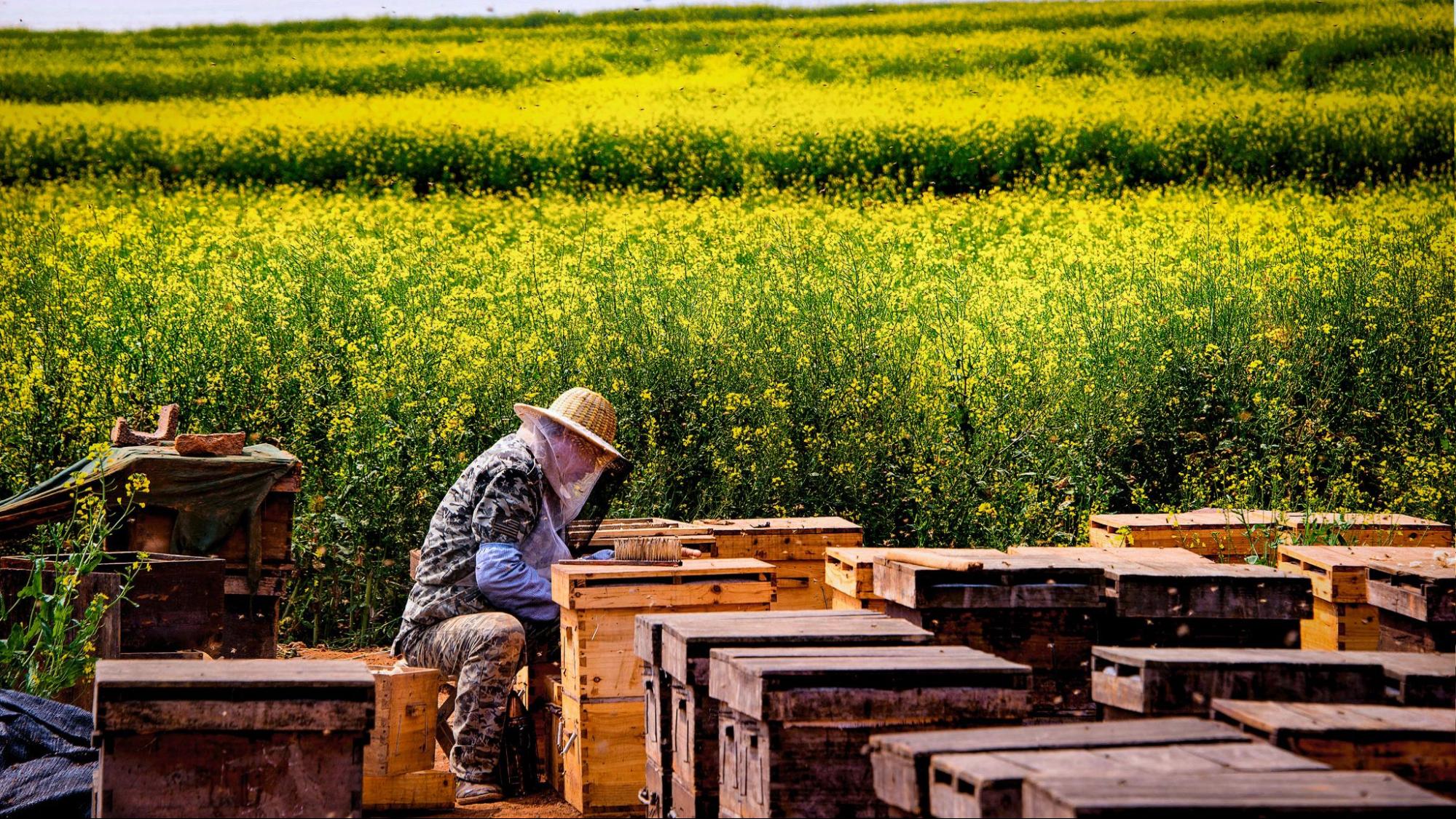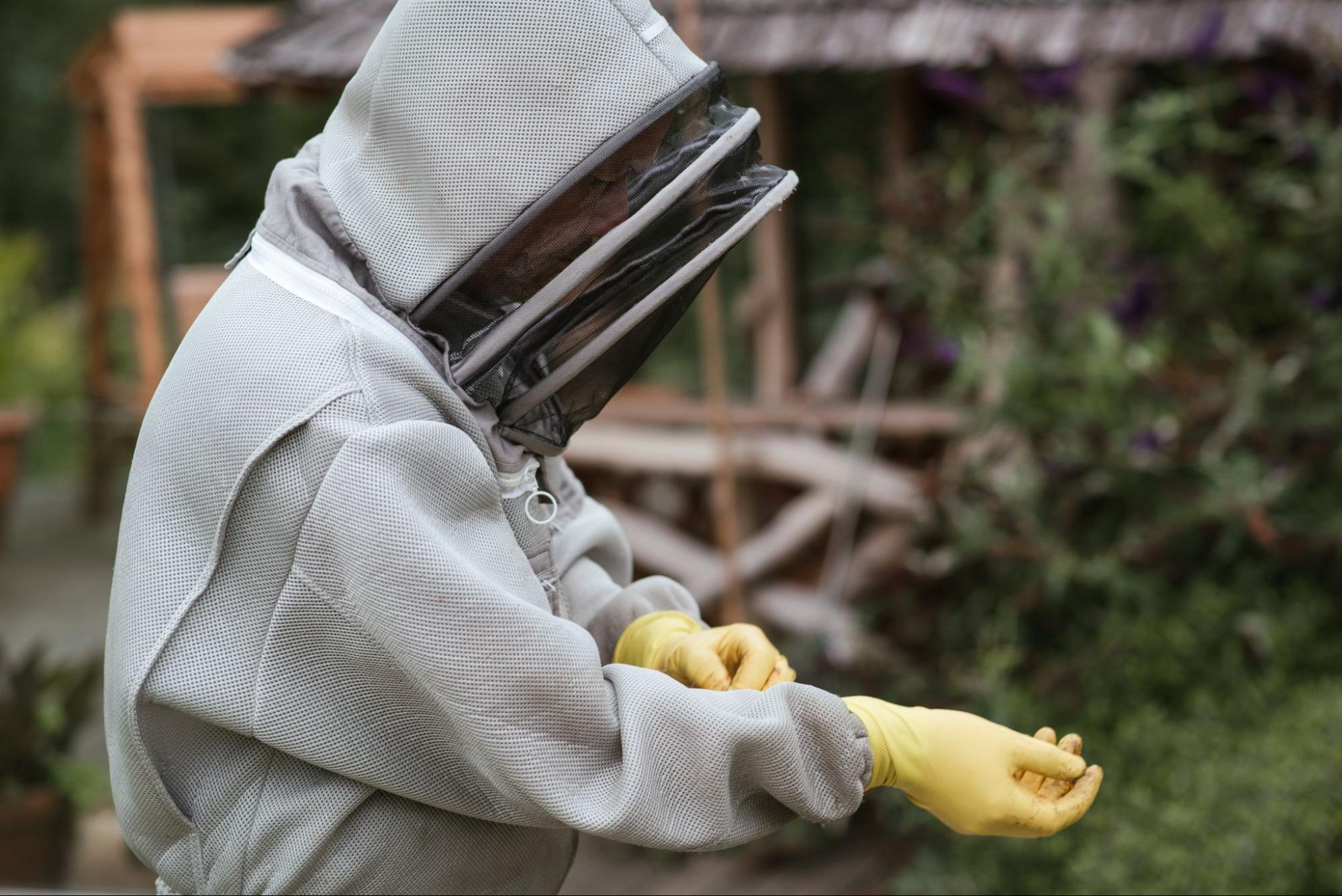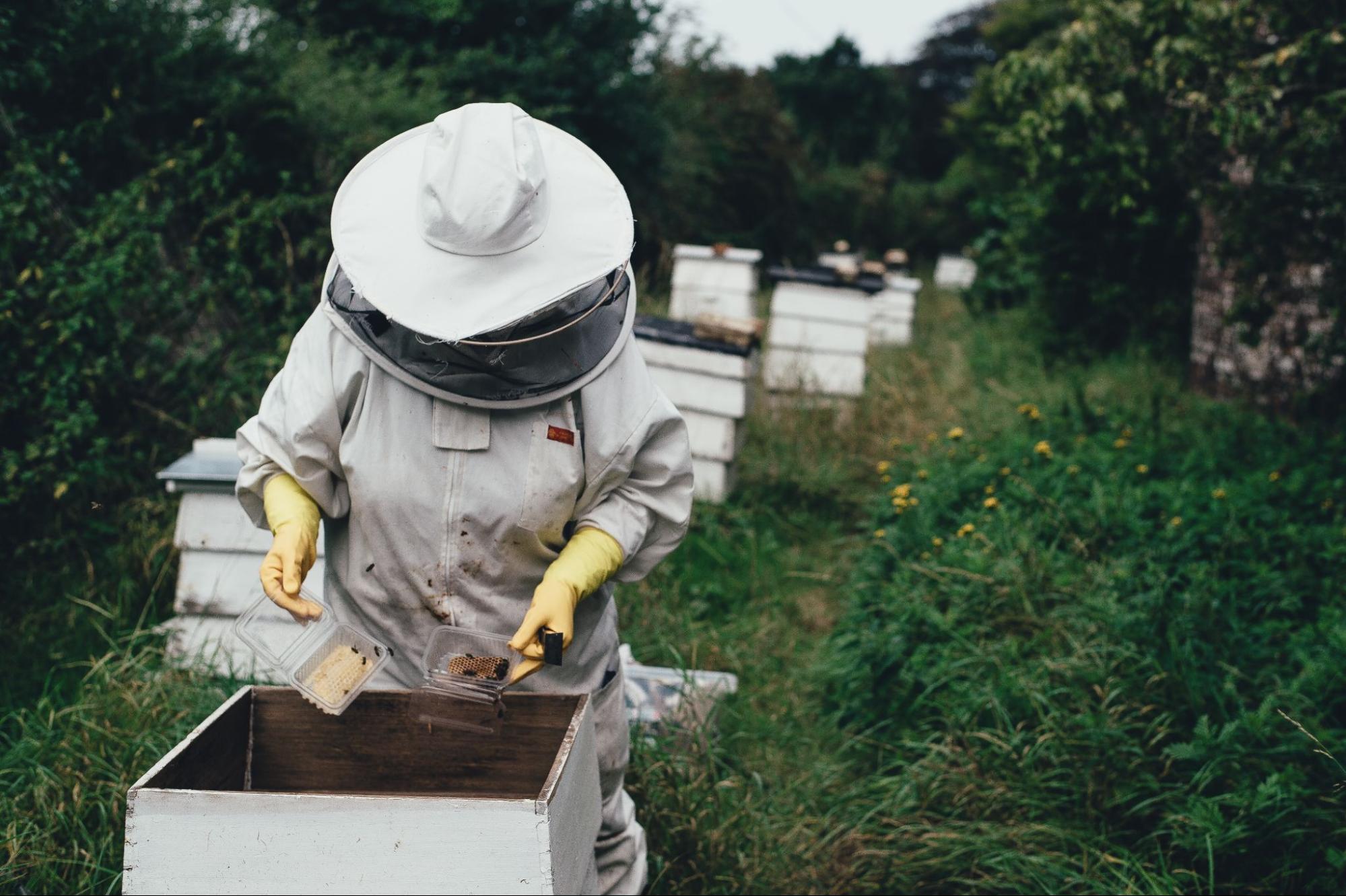7 Tips For Getting Started With Beekeeping

Honey bees are strangely addictive. As soon as you start learning about them, you want to know more about the specifics of keeping bees. You read blogs and visit apiaries—and before you know it, you’re on the Internet researching what it would take to become a beekeeper.
You’re not alone. Many people get caught up in the buzz about beekeeping and decide to try it themselves. However, there are a few things you need to know before you begin this new hobby.
From equipping yourself with the right resources to connecting with your fellow bee enthusiasts, here are 10 tips for getting started with beekeeping.
Learn Everything You Can
The first step to any new project is research. There’s always something new to learn about honey bees. Educate yourself on the basics of the life of a honey bee. How do they make honey? What role does each bee play in the colony?
The more you know, the better prepared you’ll be to take on any complications or circumstances that arise. For example, if you know how to care for honey bees in the winter, you’ll be able to take the proper precautions to protect the bee hive when the weather gets cold.
Fortunately, plenty of resources are available to teach you more about honey bees and how to care for them. You can take classes, learn from an experienced beekeeper in your community, or read more from online sources.
Our blog is full of information and resources that will help you start your beekeeping hobby on the right foot.
| Researching Tip: Keep a bee journal. Note down what you learn, observe, and question. It's a great way to solidify knowledge, track progress, and guide your beekeeping journey. |
Get to Know the Community
The beekeeping community is one of the best resources for new beekeepers. Find other beekeepers in your community and connect with them to learn more about their own experiences and gain some insider knowledge.
This can be a great help when you’re just starting out. Every new situation with your bees will cause you to have a dozen more questions. This kind of connection and camaraderie will remain beneficial throughout your beekeeping career.
That’s why there are plenty of beekeeping organizations and clubs throughout the country on local, state, and national scales. The more you get to know your fellow beekeepers, the more you’ll be able to share stories, advice, and experiences. Who knows, you might even make a few lifelong friends.
Talk to Your Neighbors
Many people are surprised at all the different places you can keep a new bee hive. Some beekeepers even work in their urban cities, keeping their bee hives on rooftops or community gardens.
Just because your honey bees can adapt to many different environments doesn’t mean your neighbors will be happy to see them around. Lots of people view bees, wasps, and other stinging creatures as the same, which means they’ll be pretty apprehensive about their new buzzing neighbors.
You can’t force anyone to like your honey bees, so a heads-up can go a long way. Before you purchase your bees, talk to your neighbors about them. Calmly explain that honey bees usually only sting when they feel threatened and that your bee hive will be good for the surrounding environment.
You might even sweeten the deal by providing them with jars of honey at the end of the season!
Choose Your Location Carefully

Before your bees arrive, you must figure out where you want your beehive. There are many factors to consider when you’re choosing your beehive location. You need to make sure your bees will have a safe water source nearby.
Honey bees can travel a couple of miles from their hive to find pollen- and nectar-rich flowers, but it always helps to make sure there are bee-friendly gardens or sanctuaries close by. You should also take your region’s weather and seasons into account. If you get harsh winds, make sure you install your hives near a wind barrier.
You should keep your own safety in mind when choosing a location, too. Place the hive somewhere you can easily access, preferably without having to haul your equipment for miles every time you want to collect honey or perform an inspection.
Become Familiar with Local Regulations
Before you set up your hive, ensure that you are aware of the local laws and regulations about beekeeping in your area. These can vary greatly depending on your location and can include rules about hive placement, the number of hives permitted, registrations or permits required, or even whether beekeeping is allowed at all.
Abiding by these rules can prevent potential problems down the road and will ensure that your new beekeeping hobby doesn’t stir up any unnecessary conflicts with your community or local government.
Invest in Healthy Bees
Ensuring the health of your bees should become a top priority once you venture into beekeeping. Purchase your bees from a reliable and reputable source to avoid any potential disease or parasite issues.
Regular inspection of your hive for diseases and pests should include checking the new brood. If you notice anything unusual, be prepared to take action immediately by consulting with local beekeepers or bee organizations for treatment options.
It's also important to provide plenty of food and water, especially during cooler months when resources are scarce for bees in your area.
| Health Check Protocol: Learn to identify common bee diseases and pests, such as Varroa mite and American foulbrood. Quick identification leads to timely treatment, safeguarding your hive's health. |
Keep Detailed Records
Remember to keep a record of each visit you make to your hive. Note down details such as hive behavior, honey production, any noticeable changes in the colony, or any treatment implemented.
Keeping track of your observations and tasks can help you refer back to previous incidents, recognize patterns, and make informed decisions moving forward. This can be especially helpful when you experience challenges and need feedback from the beekeeping community.
Don’t view this as an added task but rather something that will ultimately make you a more successful beekeeper.
Get the Right Equipment

Ensure you have all the necessary beekeeping equipment before purchasing your bees. A soft-bristled bee brush, a smoker, and a hive tool are three of the most essential tools in a beekeeper’s toolbox.
Of course, it doesn’t hurt to stock up on honey bee books and other educational resources, either. This is also the time to purchase any protective gear you need. A protective helmet and veil are essential, even if you don’t wear other pieces of protective clothing—a sting to the eyes, nose, or mouth can hurt a lot!
Many beekeepers eventually leave the full-body beekeeping suit, but it doesn’t hurt to have one when you’re starting out. You can also opt for a lighter beekeeper jacket and jeans. The most important thing is that you’re comfortable moving around your bees. If you’re nervous, they’ll notice and start getting agitated.
Additionally, it’s always a good idea to have an extra set of protective clothing around for any visitors who might come to see your hives.
We recommend having the following to get started in beekeeping:
Be sure to check our range of Beginner Essentials to simplify getting started with beekeeping!
Try New Things
The beekeeping community is buzzing with different opinions about types of hives, pieces of equipment, the best beekeeping practices, and more. No matter what questions you ask, you’re likely to get multiple answers.
A lot of the time, there is no right or wrong answer. The best answer depends on where you live, how your honey bees act, and other factors that only apply to you. This means that the best way to figure out what works best for you and your bees is to simply try it. You’ll inevitably make a few mistakes, but that’s just part of the journey.
Ensure you have all the necessary beekeeping equipment before purchasing your bees. A soft-bristled bee brush, a smoker, and a hive tool are three of the most essential tools in a beekeeper’s toolbox.
Of course, it doesn’t hurt to stock up on honey bee books and other educational resources, either. This is also the time to purchase any protective gear you need. A protective helmet and veil are essential, even if you don’t wear other pieces of protective clothing—a sting to the eyes, nose, or mouth can hurt a lot!
Many beekeepers eventually leave the full-body beekeeping suit, but it doesn’t hurt to have one when you’re starting out. You can also opt for a lighter beekeeper jacket and jeans. The most important thing is that you’re comfortable moving around your bees. If you’re nervous, they’ll notice and start getting agitated.
Additionally, it’s always a good idea to have an extra set of protective clothing around for any visitors who might come to see your hives.
We recommend having the following to get started in beekeeping:
Be sure to check our range of Beginner Essentials to simplify getting started with beekeeping!
Make Mistakes
The beekeeping community is buzzing with different opinions about types of hives, pieces of equipment, the best beekeeping practices, and more. No matter what questions you ask, you’re likely to get multiple answers.
A lot of the time, there is no right or wrong answer. The best answer depends on where you live, how your honey bees act, and other factors that only apply to you. This means that the best way to figure out what works best for you and your bees is to simply try it. You’ll inevitably make a few mistakes, but that’s just part of the journey.
Stay Passionate

There’s a reason you want to start keeping bees. Perhaps honey bees fascinate you, or your intention is to contribute positively to your local environment. It could also be that you're simply seeking an outdoor hobby that allows you to engage with nature.
As beginner beekeepers, no matter what your reasons are, keep them in mind as you learn and grow. It’s not always going to be easy—there will be bad years, colony losses, or just hot summer days when you don’t want to make the trek out to your hives.
If you remember the passion that brought you to beekeeping in the first place, getting through those bad days will be much easier.
Choosing the Best Bees for Beginners
Different species offer various benefits and challenges. The table below provides a comparison of popular bee species to help beginners make an informed decision that best suits their needs and goals in beekeeping.
| Bee Species | Temperament | Honey Production | Ease of Care |
| Italian Bees | Gentle | High | Easy |
| Carniolan Bees | Very calm, docile | Moderate to high | Moderate |
| Russian Bees | Varied, hardy | Moderate | Moderate |
| Buckfast Bees | Gentle, docile | High | Easy |
| Saskatraz Bees | Calm, gentle | High | Easy to moderate |
FAQs: Beekeeping Basics for Beginners
Here are answers to some frequently asked questions to help you get started on the right foot with your beekeeping journey.
What role does the queen bee play in the hive?
The queen bee is central to the hive's health and productivity. She is the only bee capable of laying eggs, ensuring the colony's growth and survival. A healthy queen can lay up to 2,000 eggs per day during peak seasons, directly influencing the hive's population and the number of worker bees available for foraging and care of baby bees.
How can I support my worker bees during the nectar flow?
Ensure they have ample space in the bee hives to store honey and provide water sources near your hive. Joining a local beekeeping association can also offer tips and resources on managing your hives efficiently during this busy period.
What should I feed my bees periodically to supplement their diet?
Bees' food primarily consists of nectar and pollen collected from flowers. However, during periods of scarce nectar flow or in early spring before flowers bloom, you can feed your bees sugar syrup or a pollen substitute. This supplemental feeding ensures they have the energy needed for the colony's maintenance and helps support the development of baby bees.
How do I protect my bee hives from pests like the small hive beetle?
Regular hive inspections and having the right small hive beetle supplies are crucial for early detection and treatment. Keeping your hives strong with a good population of worker bees helps, as they can fend off small invaders. Consulting with a local beekeeping club can provide additional strategies and treatments to protect your hives from these pests.
When is the best time to harvest honey without affecting the bees' food reserves?
The best time to harvest honey is at the end of the summer or early fall after the main nectar flow has ended. This ensures that you only take the surplus honey, leaving enough stores for the bees to survive the winter.
Final Thoughts
Imagine the satisfaction of uncapping your very first honeycomb, the sweet scent of honey wafting through the air, and knowing that you’ve played a crucial role in nurturing these remarkable creatures. This is the joy that awaits you in your beekeeping journey.
Taking that first step can seem overbearing, but remember—every experienced beekeeper was once a novice. Equip yourself with knowledge, surround yourself with a supportive community, and remind yourself to be patient and persistent.
Celebrate small victories and learn from the challenges. These are all part of your beekeeping adventure. Just as bees rely on their hive, you can rely on Mann Lake to provide the tools, tips, and resources you need. Happy beekeeping!

